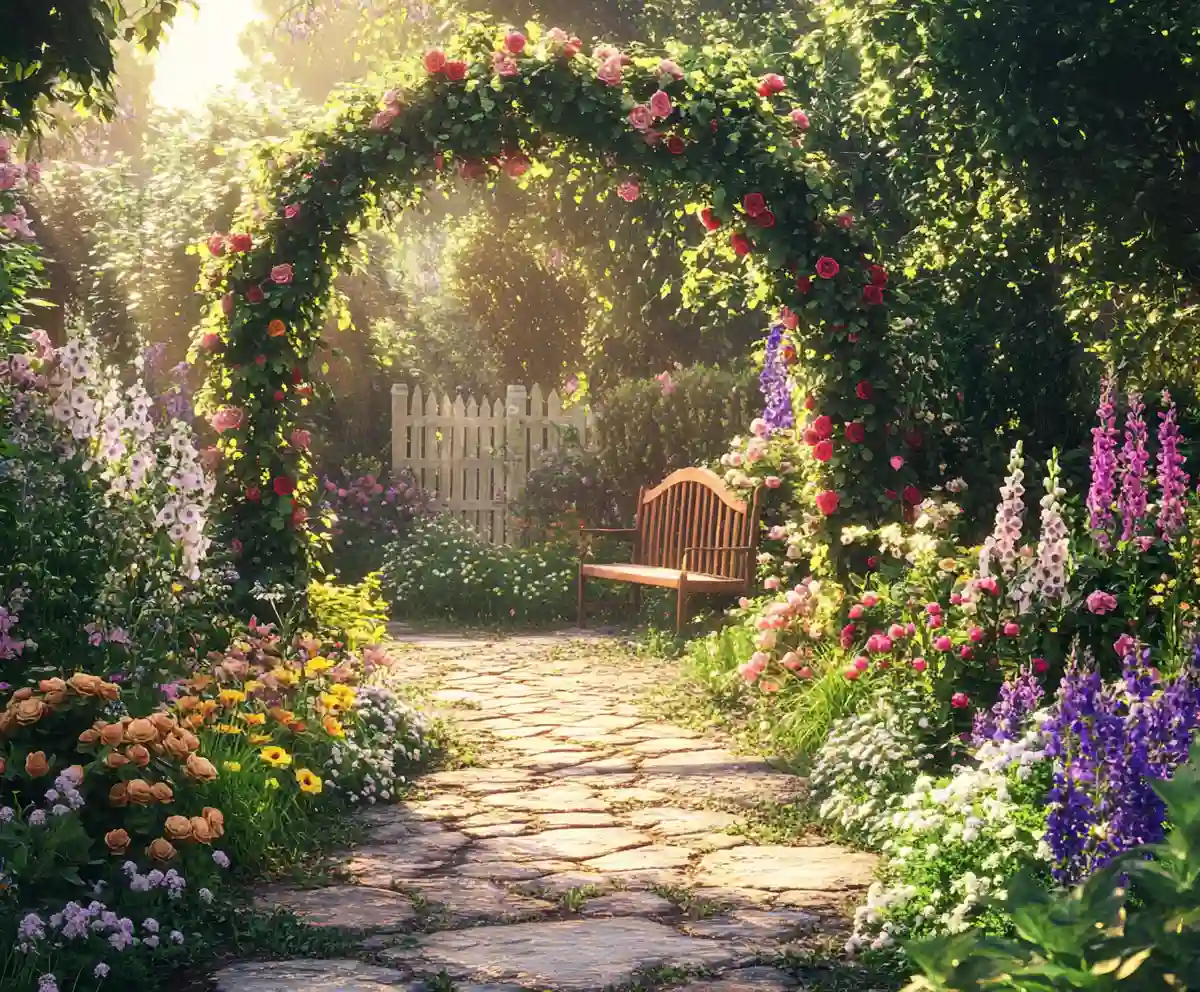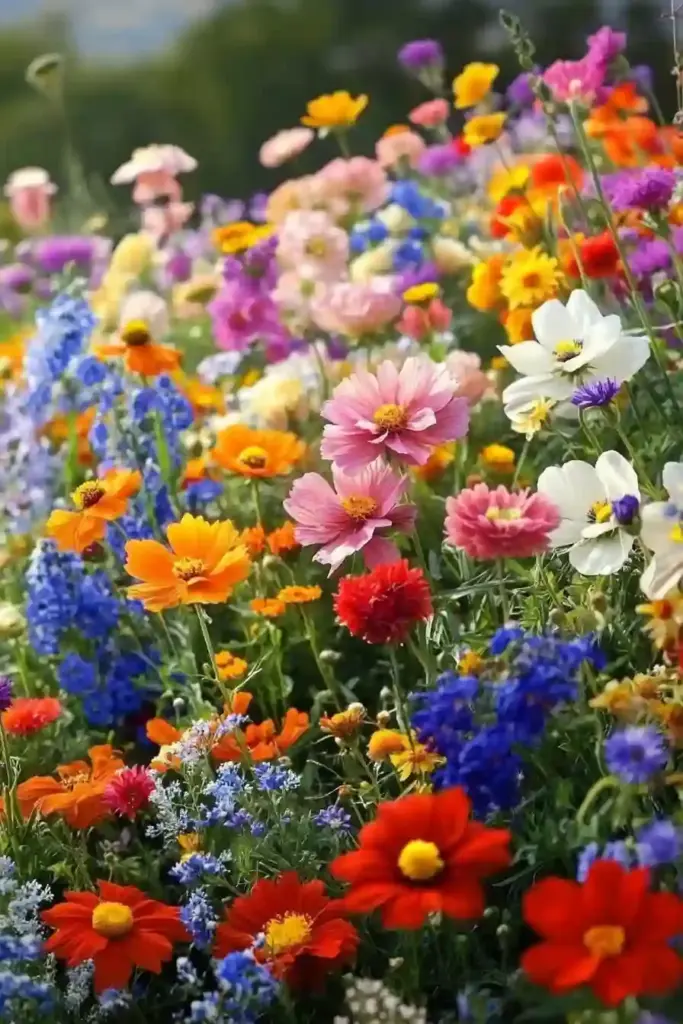Step into a world of storybook charm with an English cottage garden that blends whimsy, color, and practicality. Whether you’re transforming a spacious backyard or a cozy patio, this classic garden style invites you to fill every corner with lush greenery, fragrant blooms, and rustic touches that feel both curated and carefree.
In this guide, we’ll explore 24 inspiring English cottage garden ideas—from meandering stone paths to vibrant herb patches—designed to help you turn your outdoor space into a peaceful, flower-filled retreat. Each idea celebrates natural beauty, supports pollinators, and adds that nostalgic, countryside warmth you’ll love coming home to.
🌼 Wildflower Wonderland
Nothing captures the soul of an English cottage garden quite like a burst of wildflowers. These unstructured, colorful blooms bring life, movement, and a carefree spirit to your garden. Think cheerful daisies, cornflowers, foxgloves, and poppies swaying gently in the breeze, mingling in delightful disarray.
Wildflowers are not only visually stunning—they’re also low-maintenance and incredibly beneficial for local ecosystems. They attract bees, butterflies, and other pollinators, helping your garden thrive naturally. For best results, choose a mix of native wildflowers suited to your region and let them self-seed over time.
🌸 Tips to Create a Wildflower Section:
- Use seed mixes specifically designed for cottage gardens or pollinator habitats.
- Plant in drifts rather than rows for a more natural look.
- Let them spread! Wildflowers look best when they grow freely without much intervention.
- Combine with ornamental grasses or taller perennials for added texture and contrast.
🌿 Herb Haven
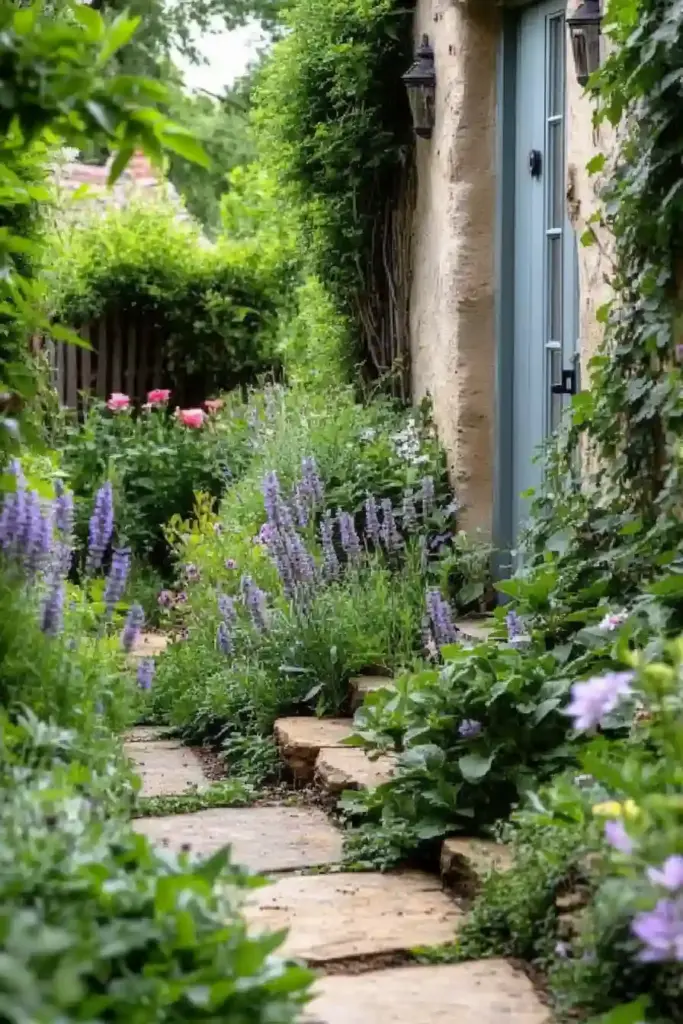
An English cottage garden isn’t complete without the intoxicating scent and practical charm of herbs woven throughout your landscape. Beyond their culinary uses, herbs like lavender, thyme, mint, and rosemary add texture, color, and fragrance to your garden beds and pathways.
These plants thrive in sunny spots with well-drained soil, making them perfect companions to the vibrant flowers around them. Interplanting herbs among flowers not only enhances your garden’s sensory appeal but also deters pests and encourages biodiversity.
🌱 How to Add Herbs to Your Cottage Garden:
- Create borders of lavender or rosemary to frame walkways with scent and softness.
- Nestle mint near seating areas for an occasional breeze of fresh aroma (just keep it contained—mint spreads fast!).
- Include chives and basil near your veggie patch for both beauty and usefulness in the kitchen.
- Try vertical herb stacks or containers to maximize small spaces.
Herbs are where practicality meets romance in the cottage garden. Plus, harvesting your own fresh ingredients feels deeply satisfying and sustainable.
🌹 Rose Retreat
If there’s one flower that truly embodies the timeless elegance of an English cottage garden, it’s the rose. With their rich fragrances, velvety petals, and wide range of colors, roses bring a sense of romance and classic beauty that few other plants can match.
Forget perfectly manicured rose beds—in a cottage-style garden, roses are meant to mingle. Let them climb over arbors, spill across fences, or mix freely with delphiniums and foxgloves for that effortless, overflowing look.
🌺 Tips for a Dreamy Rose Corner:
- Choose old-fashioned varieties like English roses or climbing heritage types for their scent and form.
- Mix with perennials and herbs like catmint or sage to soften their edges.
- Add a rustic bench or wrought-iron archway for a romantic touch (and a great photo spot).
- Ensure they get 6+ hours of sun, good airflow, and rich, well-drained soil.
Pairing structure with wildness, a rose retreat invites you to pause, breathe deeply, and just enjoy the moment. It’s a little oasis of floral magic right in your own backyard.
🪴 Meandering Pathways
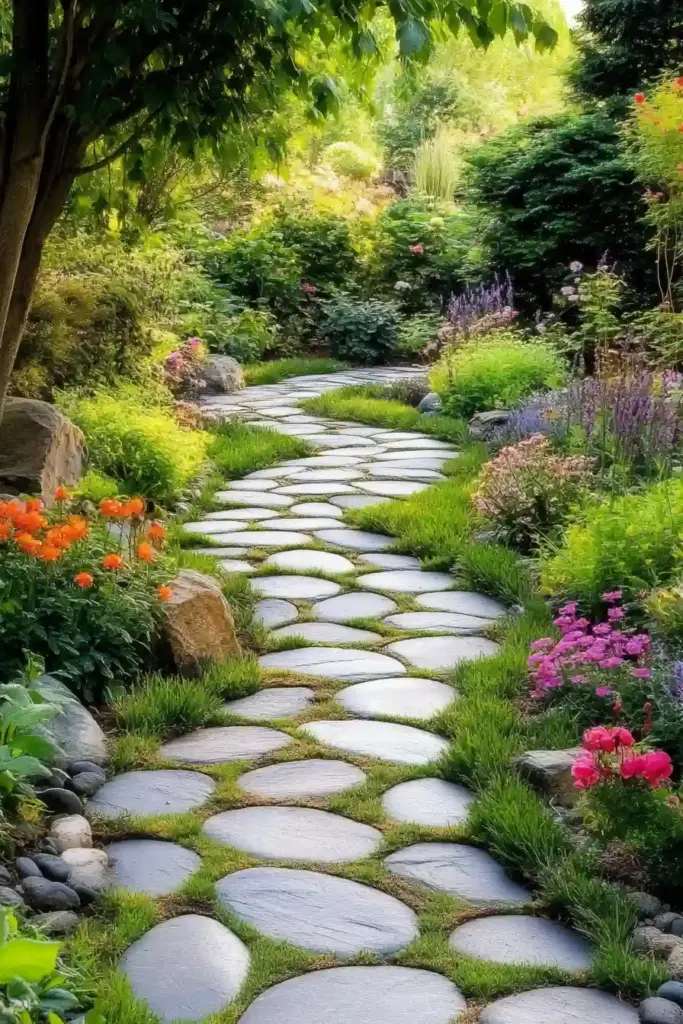
One of the most enchanting elements of an English cottage garden is the winding, whimsical pathway. These gentle curves invite exploration, guiding you through layers of blooming borders and fragrant herbs, while revealing delightful garden nooks at every turn.
Rather than formal, straight lines, meandering paths embrace the garden’s natural flow. They feel spontaneous, even a bit secretive—like each step might lead to a hidden bench, a quiet pond, or a burst of unexpected color.
🧱 Design Tips for Cottage Garden Paths:
- Use natural materials like flagstone, gravel, or reclaimed brick for a rustic, timeworn charm.
- Edge the paths with low-growing plants like alyssum, thyme, or lady’s mantle to soften transitions.
- Add small curves and forks to create visual interest and a sense of mystery.
- Consider including stepping stones through lawn or mossy areas for that fairytale vibe.
These paths do more than connect spaces—they set the mood and make your garden feel like an immersive, lived-in landscape.
🥕 Cottage Vegetable Patch
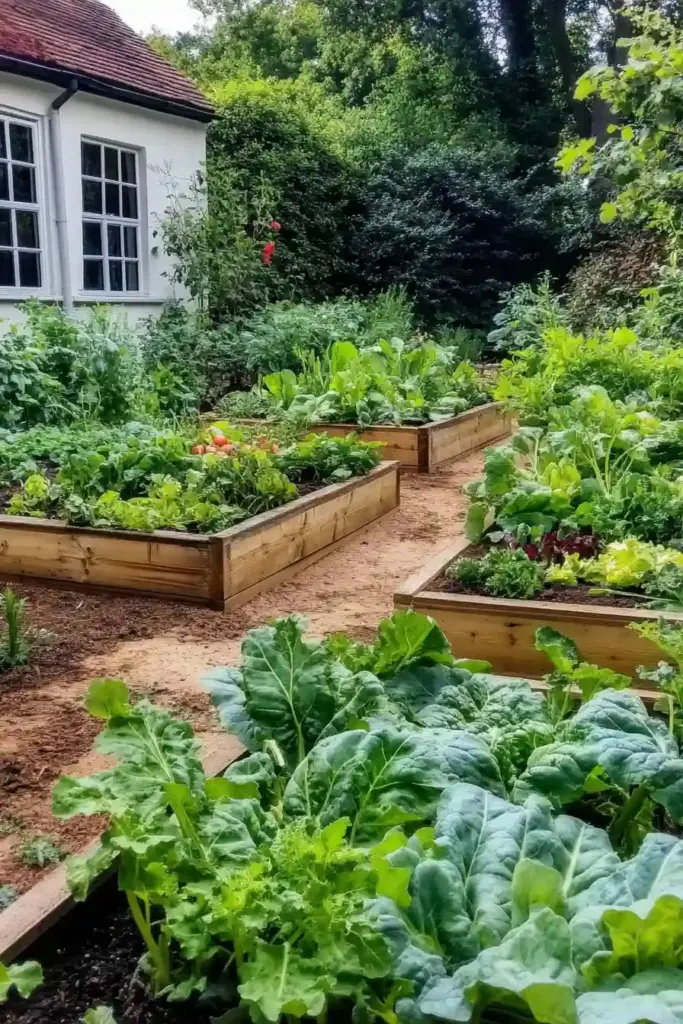
A true English cottage garden isn’t just about aesthetics—it’s also about abundance. That’s where the cottage vegetable patch comes in. Nestled among the flowers, a tidy (yet charmingly untamed) veggie patch brings life, flavor, and functionality to your garden.
Think raised beds overflowing with leafy greens, tomatoes climbing wooden trellises, and cheerful rows of carrots and beans nestled between marigolds and nasturtiums. It’s a beautiful balance of beauty and productivity, where every square foot works double duty.
🌱 Tips for a Productive & Pretty Veggie Patch:
- Blend edibles with ornamentals: Mix lettuce with calendula, or plant basil alongside zinnias.
- Use rustic wooden raised beds or woven willow edging for a handmade touch.
- Add a gravel or brick path through the patch for easy access and visual charm.
- Grow climbing veggies like peas or beans on teepees made from reclaimed wood or branches.
The vegetable patch adds heart to your garden. It reminds you to get your hands dirty, savor the seasons, and enjoy the literal fruits (and veggies!) of your labor.
💧 Pond Paradise
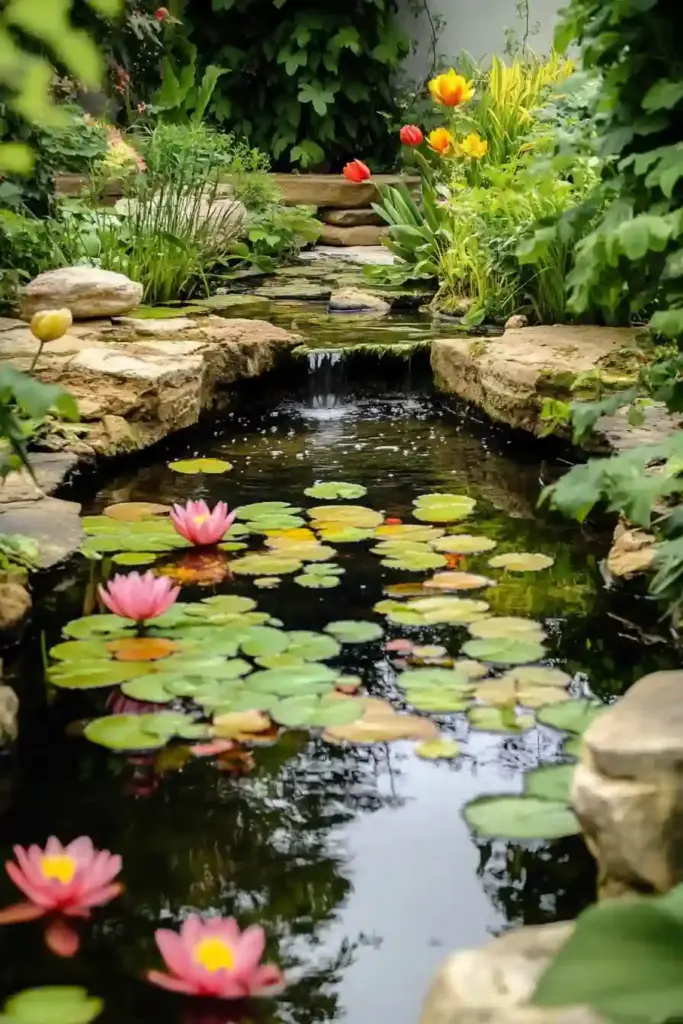
Adding a pond to your English cottage garden introduces a whole new layer of charm and tranquility. Whether it’s a natural-looking water feature nestled among plants or a quaint lily-covered pond with a stone border, water brings soothing movement, reflections, and wildlife to your outdoor space.
Ponds are not just beautiful—they’re functional ecosystems. They attract frogs, birds, dragonflies, and beneficial insects that help balance your garden naturally. With the right placement and plants, your pond can become a vibrant focal point that ties your entire landscape together.
🌿 Ideas for a Cottage-Style Pond:
- Surround your pond with lush plantings like iris, hostas, or ferns for that overgrown, natural look.
- Add floating plants like water lilies or duckweed for color and cover.
- Consider a small waterfall or bubbler to keep water circulating and create a gentle, relaxing sound.
- Use flat stones or mossy edging to give it an aged, timeless feel.
Whether large or small, a pond adds a magical stillness to the garden—a quiet spot where time slows down and nature takes the spotlight.
🍏 Fruitful Orchard
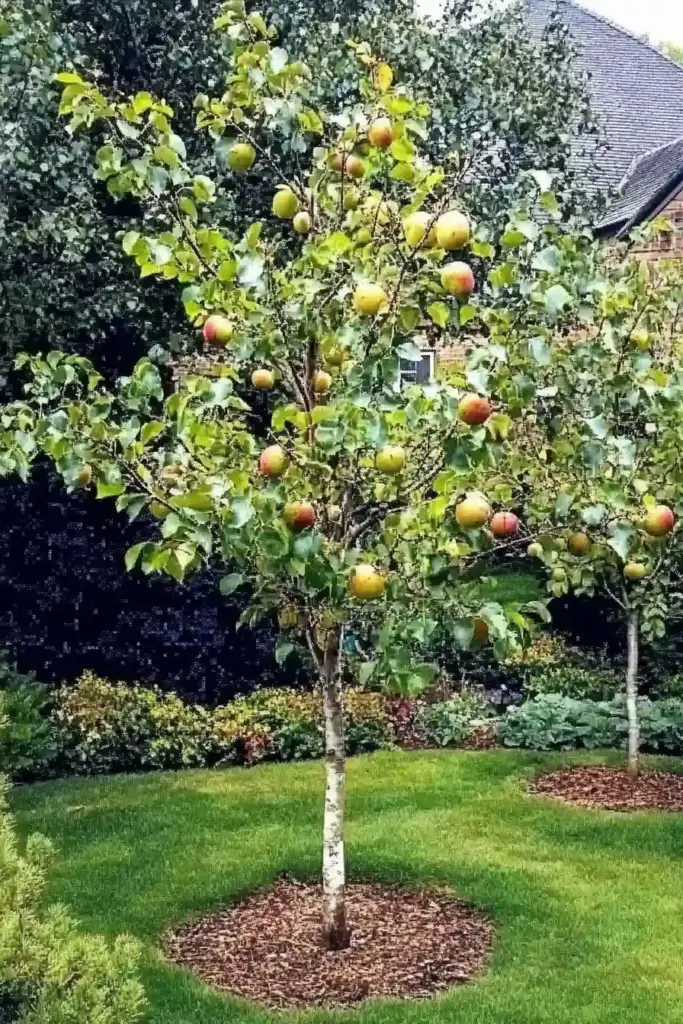
Few things capture the cozy, self-sustaining spirit of an English cottage garden like a small orchard. Whether it’s a row of apple trees lining a path or a few espaliered pear trees along a stone wall, fruit trees add seasonal beauty, structure, and, of course, delicious rewards.
The trick to a cottage-style orchard is to keep it informal and integrated into your overall design. Let flowering perennials grow beneath the trees, add rustic fencing or trellises, and invite bees and butterflies to pollinate your bounty.
🍐 Tips for a Charming Orchard:
- Choose compact or dwarf fruit trees if space is limited—apples, plums, figs, or cherries work beautifully.
- Plant wildflowers or clover under the canopy to encourage pollinators and naturalize the space.
- Use espalier techniques along fences or walls to save space and add visual interest.
- Include a rustic seating area nearby—there’s nothing better than enjoying fresh-picked fruit in the shade of your own tree.
With each changing season, your orchard evolves—from spring blossoms to summer shade, fall harvests to winter silhouettes. It’s a dynamic, edible centerpiece that brings both beauty and bounty to your garden.
🌸 Colorful Borders
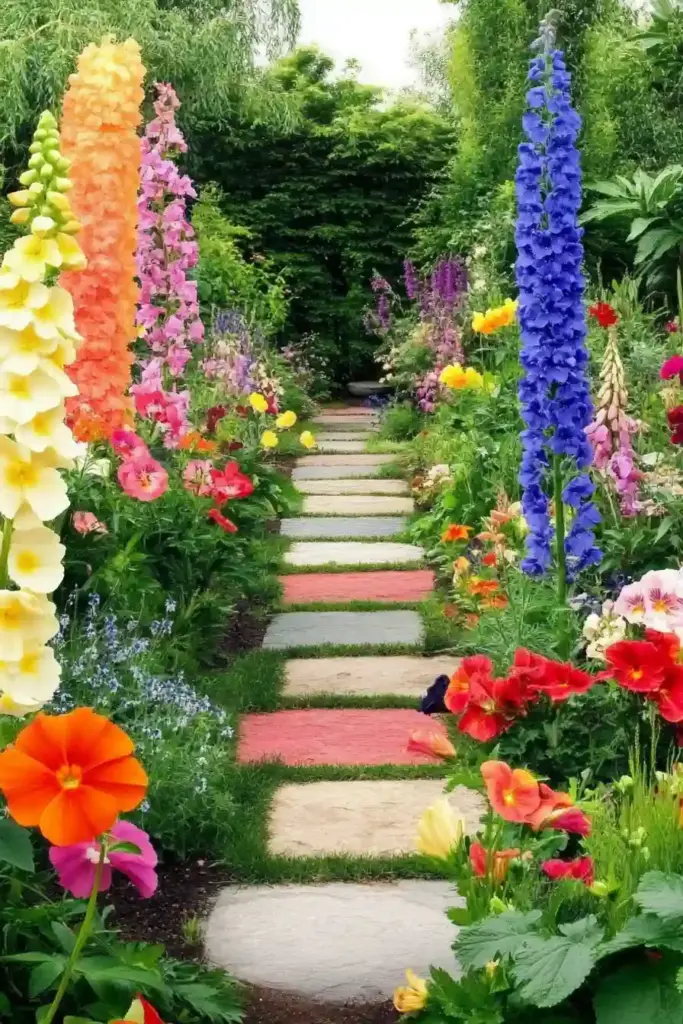
Color is the heart and soul of any English cottage garden, and nothing delivers a vibrant visual impact quite like densely planted, layered borders. These flower-packed edges frame your garden paths and beds, overflowing with a harmonious mix of shapes, heights, and hues that change with the seasons.
The goal isn’t symmetry—it’s abundance. Cottage garden borders are meant to look joyful, spontaneous, and slightly wild, like a canvas painted by nature herself.
🌼 Tips for Lush, Colorful Borders:
- Layer by height: Place tall bloomers like hollyhocks and delphiniums at the back, medium growers like foxglove and salvia in the middle, and low spreaders like alyssum or violas in front.
- Mix perennials with annuals to keep color going all season long.
- Use a color theme—like pastels, jewel tones, or warm sunset hues—for visual cohesion.
- Allow a few plants to self-seed and spread naturally over time for that lived-in charm.
Well-designed borders not only boost curb appeal but also invite you deeper into the garden, each step unveiling new textures, scents, and surprises.
🪑 Rustic Seating Nook
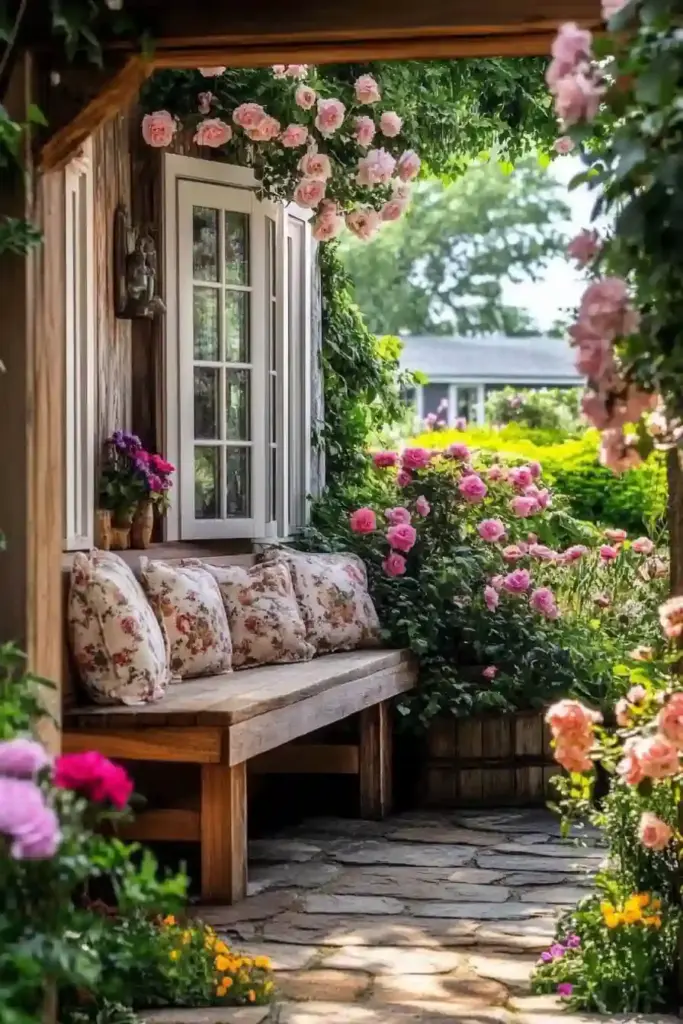
Every English cottage garden needs a quiet spot to sit, reflect, and soak up the beauty. A rustic seating nook isn’t just functional—it’s an invitation to pause. Whether it’s a weathered wooden bench beneath a flowering arbor or a bistro set tucked between lavender and roses, this little corner becomes the soul of your garden.
It’s where morning coffees taste better, books are harder to put down, and conversations feel more heartfelt.
🌿 How to Create a Charming Garden Nook:
- Use natural materials like reclaimed wood, wrought iron, or rattan for an authentic, timeworn look.
- Frame the space with tall flowers or climbing plants—wisteria, honeysuckle, or clematis work wonders.
- Add a soft cushion or vintage throw for comfort and cottage style.
- Position your nook with intention: near fragrant plants, a water feature, or a view of your favorite flowerbed.
A rustic nook transforms your garden from a place you admire to a place you live in. It’s your secret hideaway, surrounded by blooms and bliss.
🌿 Cottage Archways

Cottage garden archways are more than just structural features—they’re gateways into enchantment. Often draped with climbing roses, clematis, or honeysuckle, these arches create a sense of arrival and discovery, guiding you from one dreamy section of the garden to the next.
Whether placed at an entry point or along a winding path, archways add vertical interest and romantic flair, inviting visitors (and pollinators!) to explore what lies beyond.
🌼 Tips for a Beautiful Cottage Garden Arch:
- Choose wood or wrought iron for an authentic, rustic look that blends with the garden’s natural vibe.
- Plant climbing perennials like rambling roses, jasmine, or sweet peas at the base.
- Place archways at key transition points—entrances, pathway curves, or to frame a focal point like a bench or pond.
- Let the vines grow freely, encouraging a bit of untamed beauty that defines the cottage style.
Each arch becomes a picture frame, showcasing a glimpse of the garden’s next surprise. It’s functional, beautiful, and endlessly photogenic.
🐝 Wildlife Haven
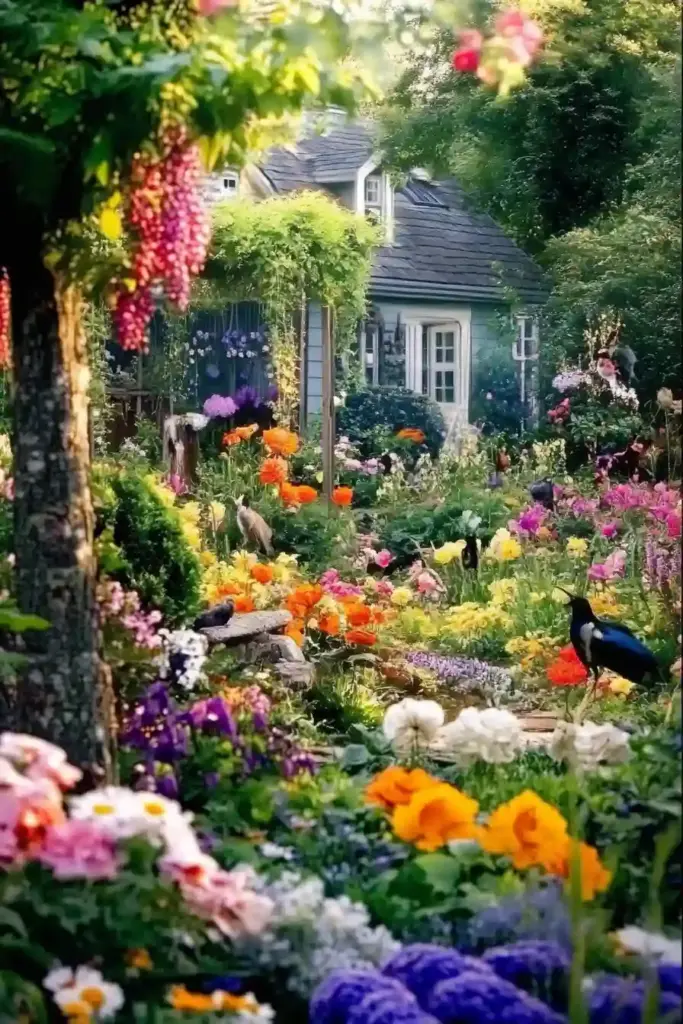
One of the most magical aspects of an English cottage garden is how alive it feels—not just with flowers, but with the gentle hum of bees, the flit of butterflies, and the cheerful chirping of birds. By creating a haven for wildlife, your garden becomes part of a larger ecosystem—and a true sanctuary.
Pollinator-friendly plants, bird feeders, and small habitats add movement and sound, while also supporting biodiversity. Plus, a lively garden just feels more joyful.
🌼 How to Attract and Support Garden Wildlife:
- Plant nectar-rich flowers like echinacea, bee balm, lavender, and cosmos to draw in bees and butterflies.
- Add birdhouses, feeders, and shallow birdbaths in quiet, sheltered areas.
- Leave a brush pile or small log stack for beneficial insects and small critters.
- Avoid pesticides and go for organic methods to keep your space safe and healthy.
Creating a wildlife-friendly garden is not only rewarding—it’s essential. You’re giving nature a place to thrive, right alongside your flowers and herbs.
🌳 Shady Retreat
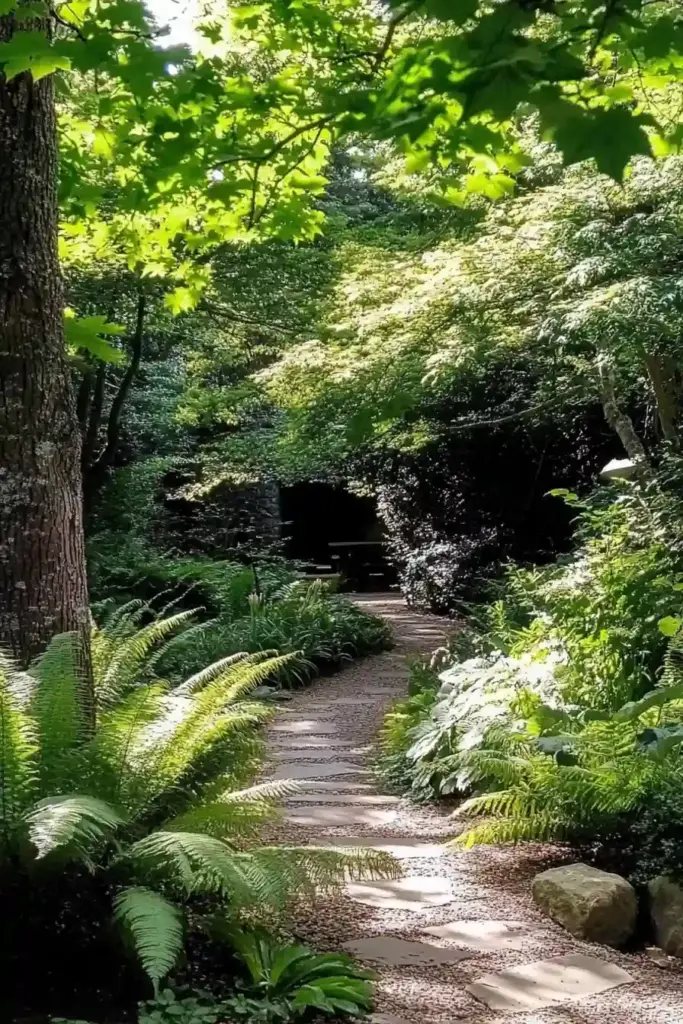
Every cottage garden needs a place to escape the summer sun, and a shady retreat offers just that—serenity, comfort, and a little relief under a canopy of green. Whether it’s beneath a mature tree or a vine-covered pergola, these quiet corners invite you to relax and reconnect with nature.
In a garden full of color and sunlight, shady spots add contrast and calm—perfect for reading, napping, or enjoying a cool drink on a warm afternoon.
🌿 Ideas for a Serene Shady Spot:
- Use shade-loving plants like hostas, ferns, astilbes, and foxgloves to add texture and color.
- Add a simple bench or hammock beneath a tree or arbor for laid-back comfort.
- Incorporate dappled light with climbing vines like clematis or ivy on pergolas or trellises.
- Include soft moss paths or ground covers for a peaceful, woodland feel.
A shady retreat isn’t just a visual element—it’s a sensory one. The cool air, rustling leaves, and filtered light create a restorative experience right in your backyard.
🌼 Seasonal Blooms
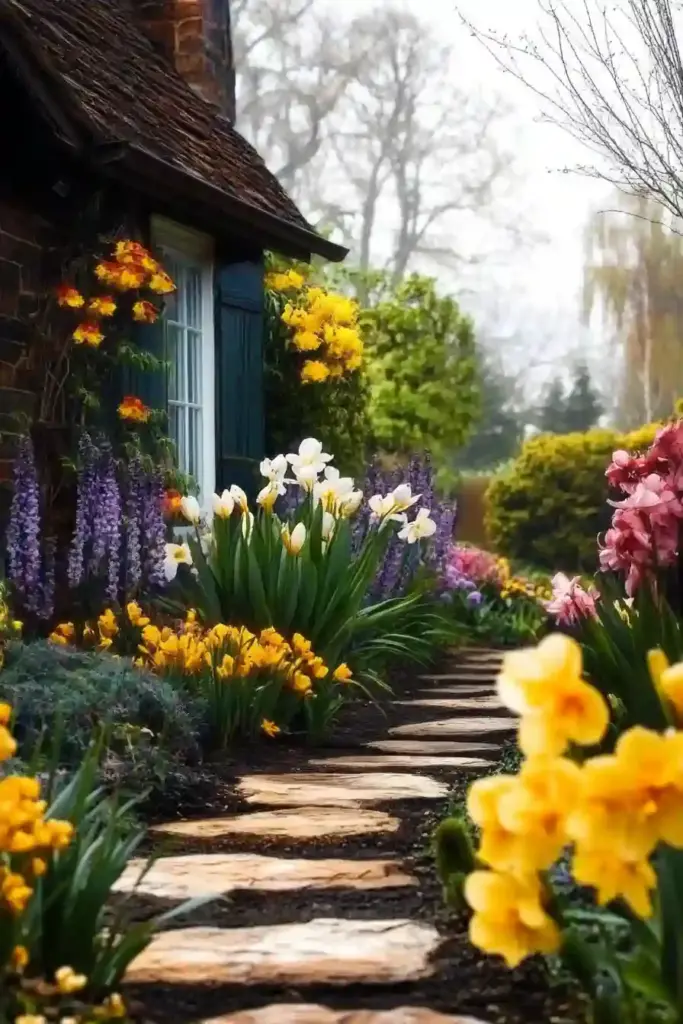
A well-planned English cottage garden offers more than just a springtime show—it’s a celebration of every season. From the first daffodils of early spring to late-summer coneflowers and autumn asters, layering your garden with seasonal blooms ensures there’s always something in flower, color, or transition.
By choosing plants that bloom in succession, your garden stays lively, ever-changing, and full of character all year round.
🌸 Tips for Year-Round Blooming:
- Spring: Start with tulips, daffodils, primroses, and forget-me-nots.
- Summer: Fill beds with lavender, roses, delphiniums, hollyhocks, and daisies.
- Fall: Add warmth with sedum, asters, and ornamental grasses.
- Winter interest: Include evergreen shrubs, structural seed heads, and colorful stems like red-twig dogwood.
Planning for seasonal variety keeps your garden fresh and dynamic—so there’s always something to admire, no matter the month.
🪷 Cottage Garden Pond
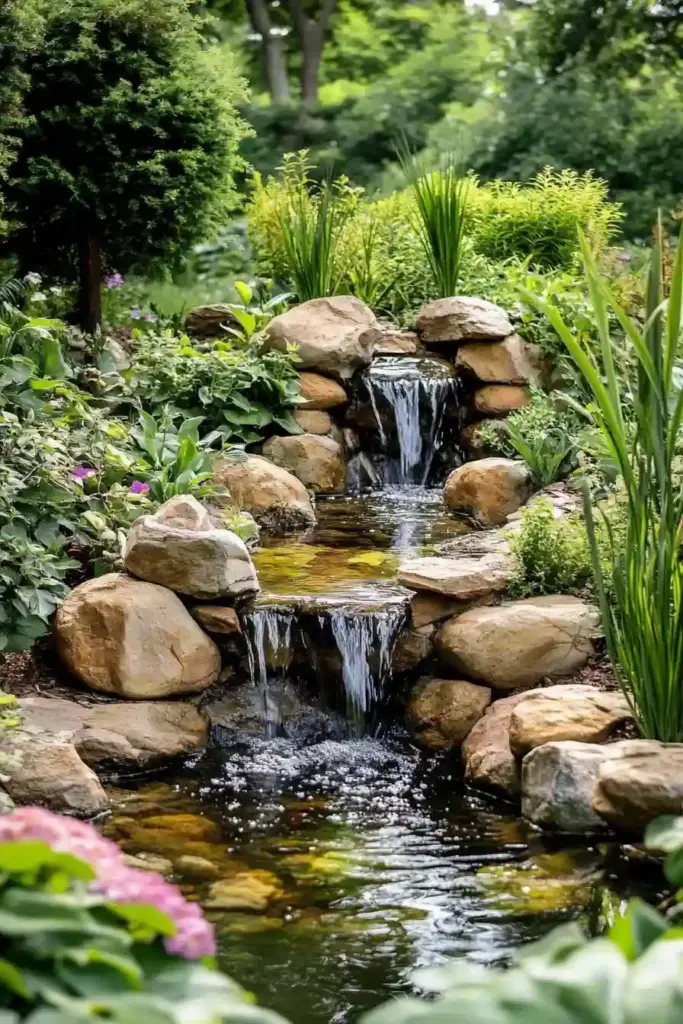
While we’ve touched on ponds earlier, a dedicated cottage garden pond deserves its own spotlight. It’s not just a water feature—it’s a serene, living centerpiece that brings balance, movement, and an irresistible sense of calm to your garden.
These ponds are often framed by informal plantings, surrounded by perennials, and filled with aquatic plants that reflect the wild, layered aesthetic of cottage style.
🌿 How to Design a Cottage Garden Pond:
- Keep the edges natural and soft—use gravel, mossy stones, and overhanging plants like creeping jenny or water irises.
- Include floating plants such as lilies or water hyacinths to provide shade and habitat.
- Let the area blend into the surrounding garden with tall flowers and grasses nearby.
- Add subtle touches like a small bench or stepping stones leading to the edge.
The pond becomes a place to pause and reflect—literally and figuratively. It mirrors the sky, hums with life, and feels like a secret oasis tucked into your garden world.
🌺 Fragrant Pathways
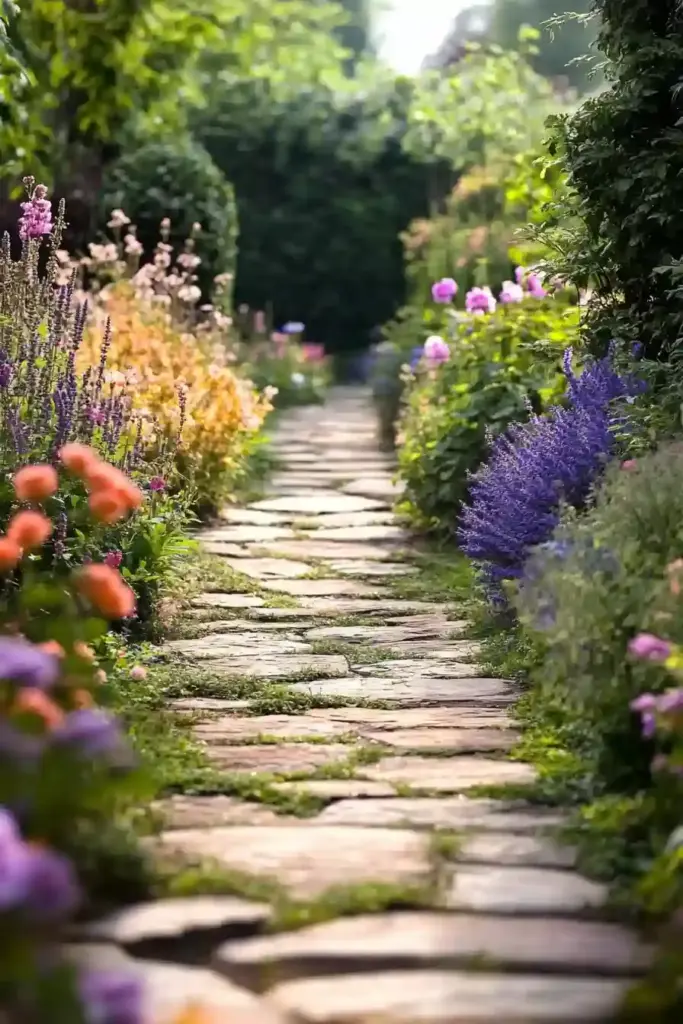
One of the most enchanting sensory experiences in an English cottage garden is walking along a path where every step releases a subtle, sweet scent. Fragrant pathways combine visual beauty with aromatic delight, turning simple strolls into immersive experiences that ground you in the moment.
By planting aromatic herbs and flowers along walkways, you’re not just decorating—you’re setting the tone for how your garden feels.
🌿 Ideas for a Scent-Filled Path:
- Line paths with lavender, rosemary, thyme, or catmint—all wonderfully aromatic and perfect for edging.
- Mix in roses, sweet peas, or stock to add floral notes and color.
- For shaded paths, try sweet woodruff or lily of the valley.
- Use gravel or stepping stones between the beds to allow fragrances to waft up as you walk.
Fragrant pathways don’t just look good—they make your garden memorable. Guests will linger, and you’ll find yourself wandering just to enjoy the air.
🌞 Cottage Garden Pergola
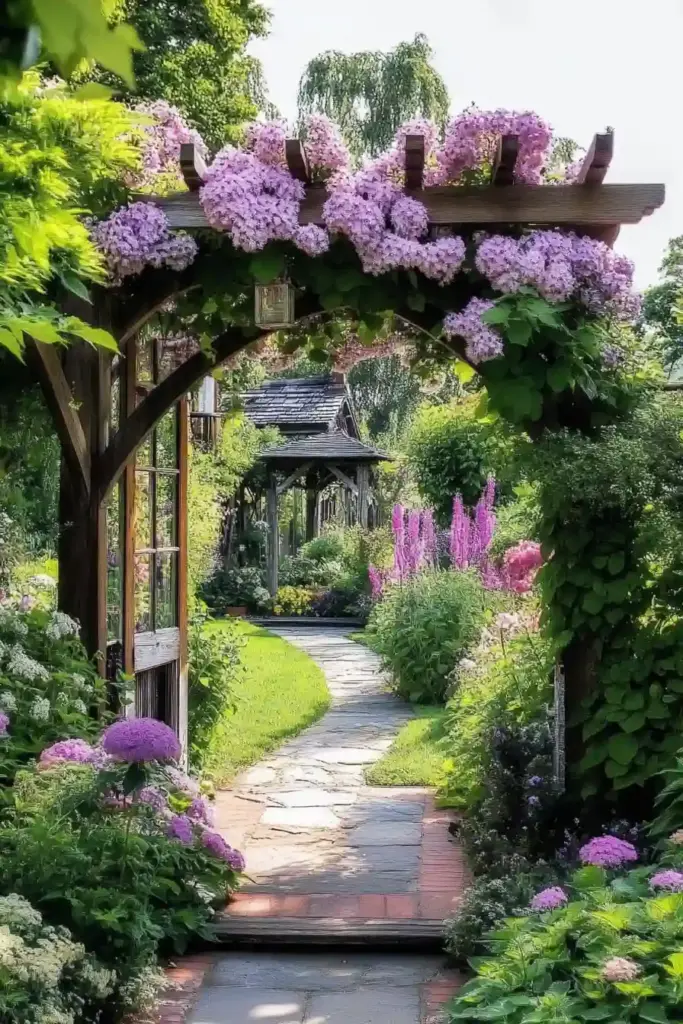
A pergola is one of the most iconic features of an English cottage garden. Not only does it provide structure and shade, but it also offers the perfect framework for climbing plants that spill over the sides in a romantic cascade of blooms and greenery.
Whether it frames an entrance, covers a seating area, or leads to a hidden corner, a pergola adds vertical drama and timeless charm to the garden.
🪴 Pergola Inspiration for Cottage Gardens:
- Train climbing roses, wisteria, or clematis to drape over the beams, creating a living canopy.
- Use weathered wood or painted timber to maintain a rustic, classic look.
- Hang vintage lanterns or string lights for added atmosphere during evenings.
- Add benches or bistro tables underneath to turn it into a garden destination, not just a feature.
A pergola blends beauty and utility, creating a cozy, protected space where the garden embraces you from all sides.
🌼 Edible Flowers
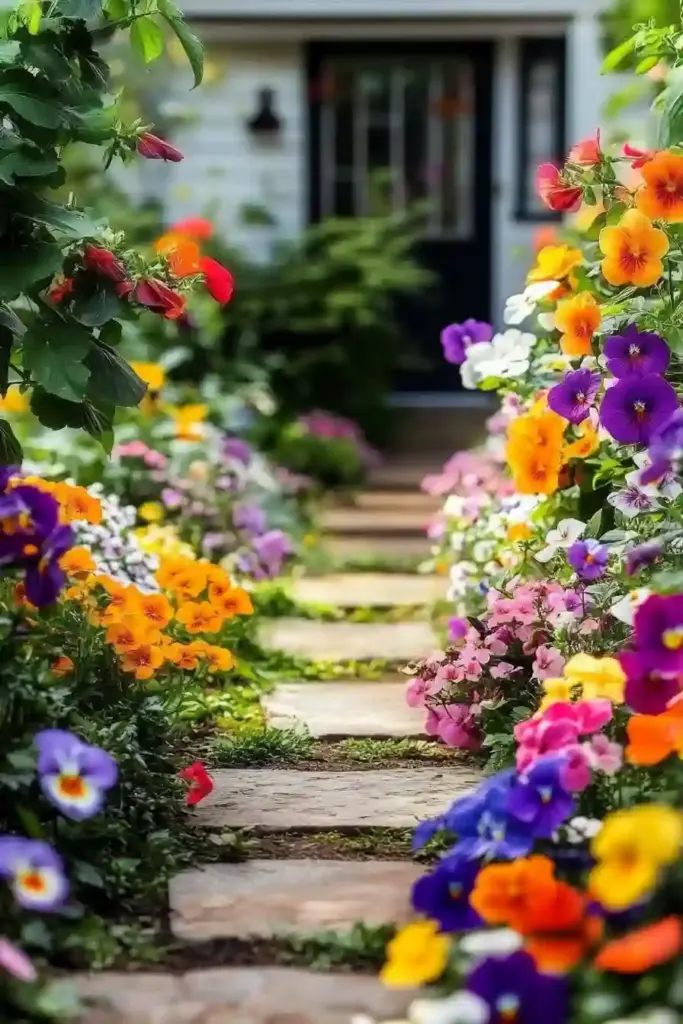
In a cottage garden, beauty and utility go hand in hand—and edible flowers are a delightful way to enjoy both. These blossoms not only add vibrant color and whimsical charm, but they also bring unexpected flavor to your kitchen. Imagine plucking a few petals to sprinkle over salads, decorate desserts, or infuse in teas.
It’s a garden experience that engages all the senses—sight, scent, and taste.
🌿 Popular Edible Flowers for Cottage Gardens:
- Nasturtiums – Peppery flavor, great for salads and pasta
- Pansies and violas – Mild, slightly sweet, and perfect for garnishes
- Calendula (pot marigold) – Bright and tangy; lovely in soups or herbal teas
- Borage – Cucumber-like flavor, ideal for drinks or frozen into ice cubes
- Chive blossoms – Add a subtle onion note to savory dishes
Plant these flowers among herbs and veggies, or in dedicated pots near your kitchen door for easy harvesting. They’re a beautiful reminder that in a cottage garden, every bloom has a purpose.
🪴 Cottage Garden Containers
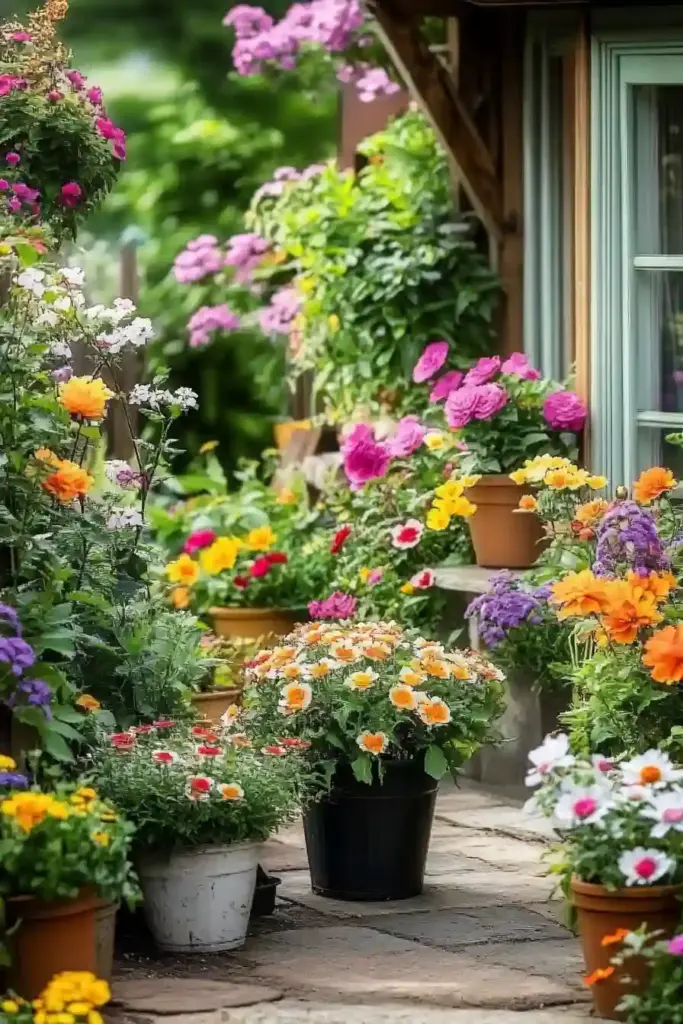
Whether you’re working with a small patio, front steps, or simply want to add height and layers to your planting scheme, containers are a cottage garden secret weapon. Overflowing pots brimming with blooms, herbs, and trailing vines instantly bring color and character to any nook or cranny.
They’re easy to move, endlessly customizable, and a great way to showcase seasonal favorites or experiment with new combinations.
🌿 Container Gardening Cottage-Style:
- Use vintage or weathered containers like terracotta pots, old buckets, or wooden crates for a rustic touch.
- Mix thrillers, fillers, and spillers: tall focal plants (like snapdragons or foxglove), mounding mid-heights (like geraniums or sage), and trailing plants (like ivy or sweet alyssum).
- Combine flowers, herbs, and even small veggies like cherry tomatoes or salad greens for an edible container.
- Cluster pots in odd-numbered groups for an artfully unplanned feel.
Container gardens bring a soft, layered look to porches, patios, pathways, and even windowsills—perfect for adding that overflowing charm without needing a full garden bed.
🧱 Natural Stone Walls
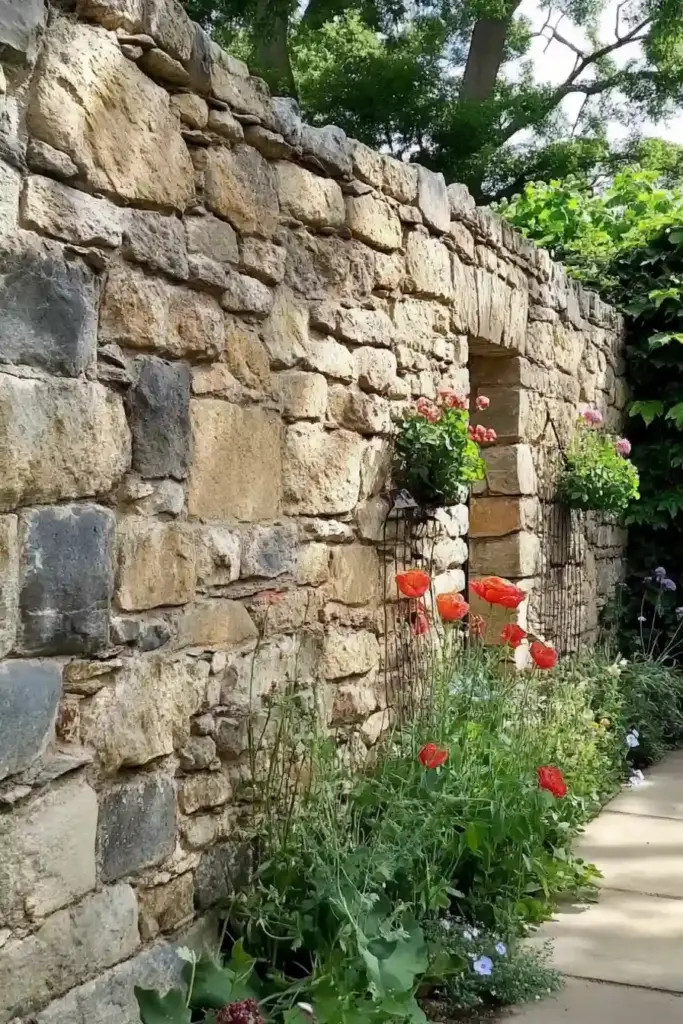
Nothing says “timeless English charm” quite like a weathered stone wall. In a cottage garden, natural stone walls do more than define space—they become part of the landscape’s beauty, offering structure, contrast, and a sense of age and permanence.
These low walls can edge flower beds, line paths, or support raised planting areas. As they age, they blend into the garden even more—especially when softened with trailing flowers or moss creeping through the crevices.
🌿 Ways to Use Stone Walls in Your Garden:
- Build low dry-stacked walls as natural dividers between planting zones.
- Edge herb gardens or borders to contain sprawling plants while adding visual texture.
- Tuck in creeping plants like thyme, campanula, or trailing lobelia to soften edges and add a pop of color.
- Use locally sourced stone for an authentic, organic look that fits your space.
Stone walls bring history and stability to your garden. Even a small wall adds layers—both visually and emotionally—to the overall design.
🐸 Cottage Garden Wildlife Pond
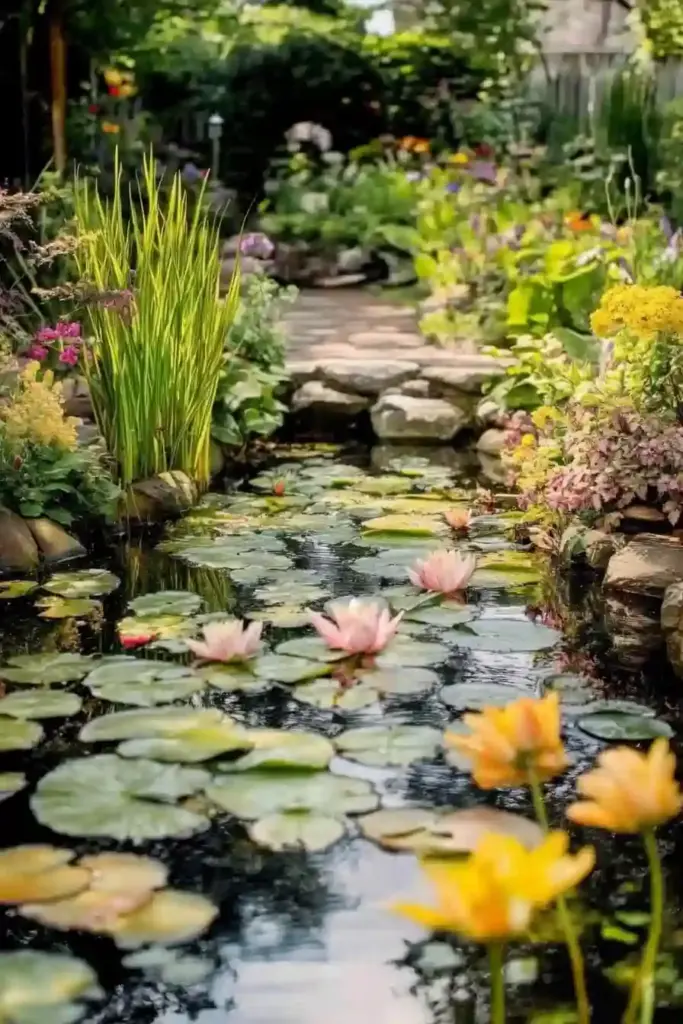
While a traditional pond adds beauty, a wildlife pond takes things a step further by transforming your garden into a thriving microhabitat. These ponds are intentionally designed to support frogs, dragonflies, birds, bees, and other beneficial critters that help maintain a natural balance in your garden.
Unlike ornamental water features, wildlife ponds are often more natural in shape and shallow at the edges, offering easy access for small creatures and a safe place to drink or bathe.
🐝 How to Create a Wildlife-Friendly Pond:
- Include gentle, sloped sides with pebbles or planting shelves so animals can enter and exit safely.
- Surround the pond with native plants and tall grasses for shelter and foraging.
- Avoid adding fish, as they may eat insect larvae and disturb the natural ecosystem.
- Keep the water oxygenated with aeration plants like hornwort or a solar-powered bubbler.
A wildlife pond becomes a hidden world within your garden—a place where frogs croak at dusk, dragonflies dance in the sunlight, and birds stop by for a drink. It adds not just beauty, but biodiversity.
🪣 Vintage Garden Decor
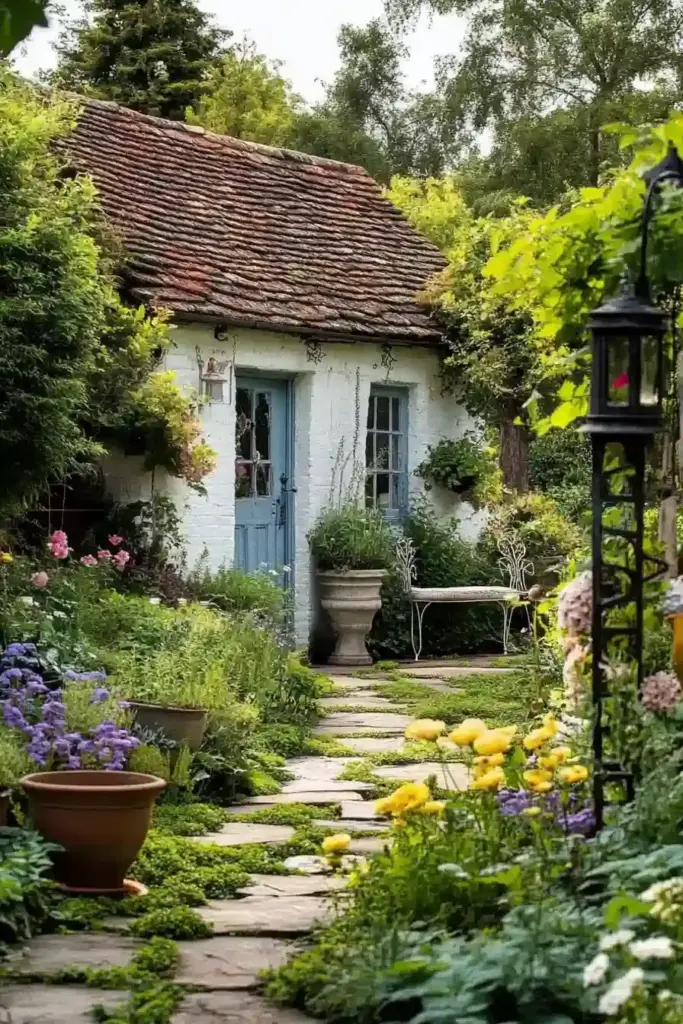
A key ingredient in the charm of an English cottage garden is the way it feels like it’s been there forever. That’s where vintage garden décor comes in—adding character, nostalgia, and a cozy sense of history to your outdoor space.
From weathered watering cans to wrought iron chairs, these pieces feel collected over time, each one telling a story. Even better? You can often repurpose or thrift them, making your garden both stylish and sustainable.
🕰️ Ideas for Cottage-Style Garden Accents:
- Display old tools, watering cans, or galvanized buckets among your flower beds.
- Use a rusty wheelbarrow or wooden crate as a quirky planter.
- Hang antique mirrors or picture frames on garden fences to reflect greenery and add depth.
- Place a cast-iron bench or vintage birdcage under a pergola or arch for a whimsical focal point.
These decorative touches blend seamlessly with the wild, layered planting style of a cottage garden. They’re not perfect—and that’s the point. The patina of age only makes them more beautiful.
🌾 Cottage Garden Meadow
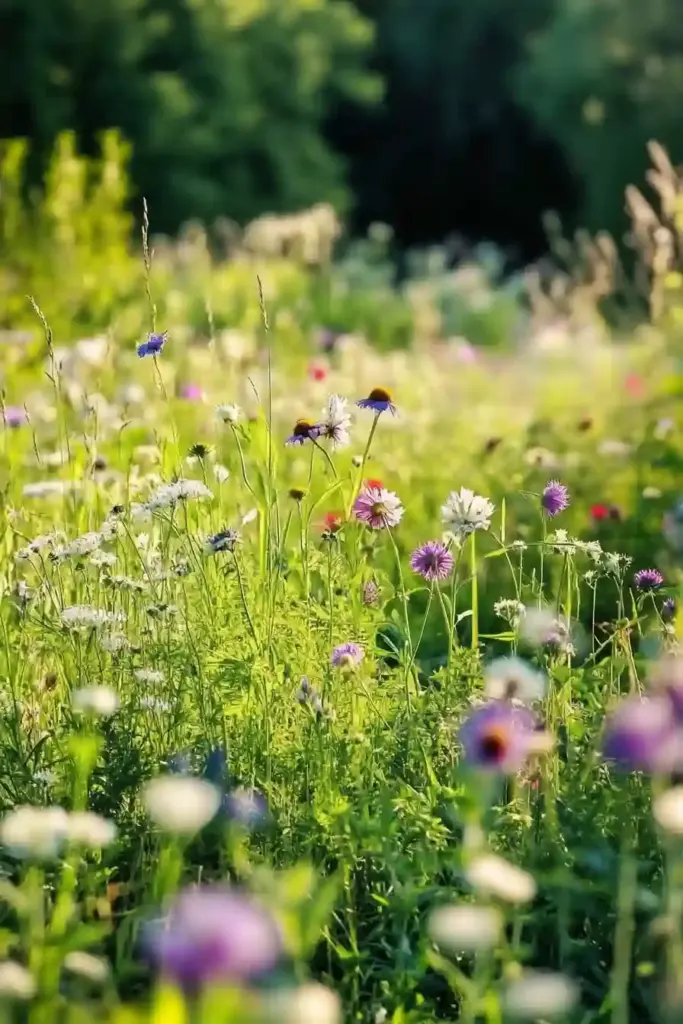
A cottage garden meadow is where order gives way to wild beauty—a patch of soft grasses, native blooms, and pollinator-friendly plants that sway in the breeze and hum with life. It’s a nod to traditional English wildflower meadows and a low-maintenance way to add drama, movement, and ecological value to your garden.
Perfect for larger areas or sunny borders, meadows bring a naturalistic touch that feels both intentional and untamed.
🌼 Tips for Creating a Meadow-Inspired Garden Area:
- Use a mix of wildflower seeds and ornamental grasses suited to your climate and soil.
- Incorporate plants with staggered bloom times—like yarrow, black-eyed Susan, cosmos, and rudbeckia—for long-lasting color.
- Mow once or twice a year, allowing seeds to drop and habitats to form.
- Add a stone path or bench to enjoy the meadow up close without disrupting its wild feel.
A meadow invites butterflies, bees, and even the occasional bunny, adding dynamic movement and natural rhythm to your garden. It’s a joyful, living tapestry you’ll never grow tired of watching.
🌿 Cottage Garden Trellis
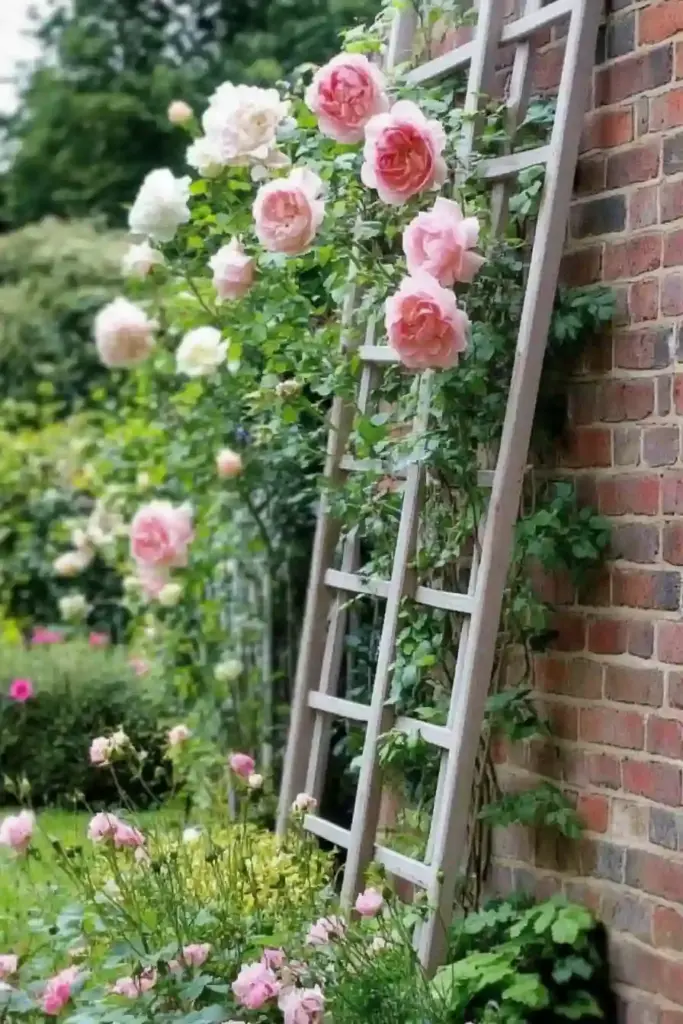
A cottage garden trellis is more than a support structure—it’s a vertical canvas for flowering vines to weave their magic. Whether used to flank a path, define a border, or create privacy, trellises bring height, romance, and visual intrigue to your space.
Wrapped in sweet peas, morning glories, or climbing roses, a trellis becomes a living sculpture—softening hard edges and adding layers of color and movement.
🪴 How to Use Trellises in Your Cottage Garden:
- Choose materials like wood, wrought iron, or repurposed fencing for a rustic aesthetic.
- Install trellises along walls, in flower beds, or at garden entrances to draw the eye upward.
- Plant quick-growing climbers like clematis, passionflower, or scarlet runner beans to fill space fast.
- Combine with arbors or pergolas for added structure and seamless vertical flow.
Trellises give smaller gardens the illusion of depth and scale while offering support for plants that love to reach for the sky. It’s a perfect blend of form and function in true cottage fashion.
🌿 Cottage Garden Herb Stack
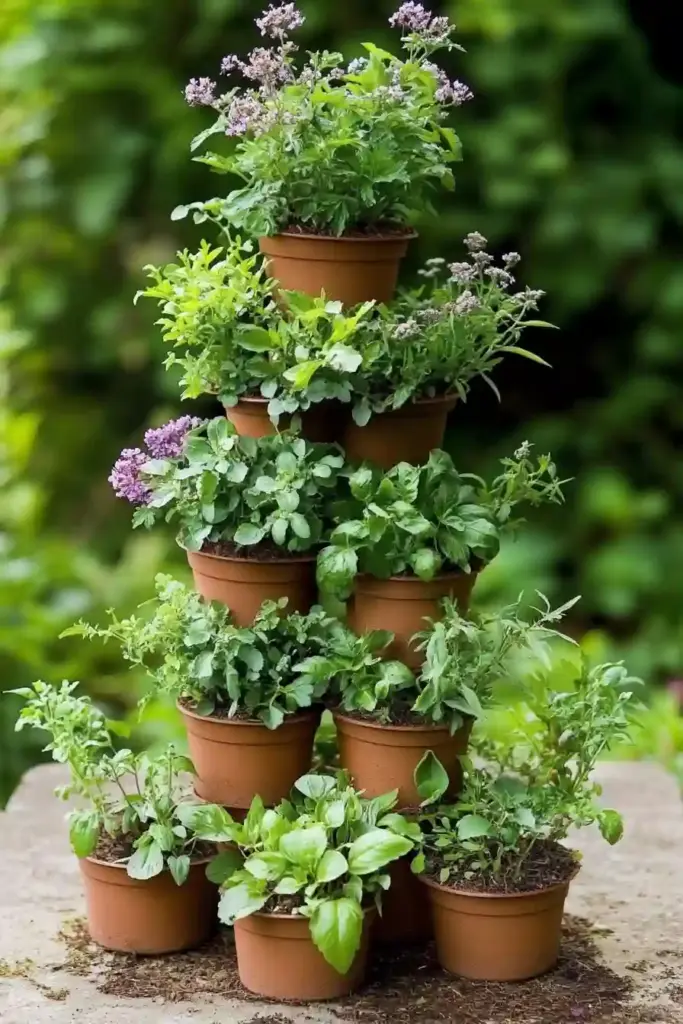
For those short on space or simply looking to add a bit of vertical variety, a cottage garden herb stack is a clever, space-saving solution that’s as beautiful as it is functional. These tiered planters bring herbs up off the ground, turning them into a living sculpture that overflows with texture, scent, and flavor.
They’re perfect for patios, kitchen garden corners, or nestled among flower beds—anywhere you want a burst of greenery with a practical twist.
🌱 How to Build and Style an Herb Stack:
- Use tiered planters, old terracotta pots, or stacked wooden crates to create layers.
- Combine complementary herbs—like basil, oregano, thyme, parsley, and mint.
- Place sun-loving herbs on top, where they get the most light, and shade-tolerant ones below.
- Let trailing varieties like creeping thyme or lemon balm spill down the sides for that cascading cottage look.
An herb stack keeps your favorite flavors within reach while adding height and interest to your garden. It’s the perfect blend of compact design and cottage garden spirit.
🌺 Wrapping Up: Your English Cottage Garden Awaits
Creating an English cottage garden is more than planting pretty flowers—it’s about crafting a space that feels alive, personal, and joyfully unstructured. With winding paths, overflowing borders, and cozy corners filled with scent and color, every element adds to the storybook charm of your outdoor space.
By blending function with beauty—like herb stacks, wildlife ponds, and vegetable patches—you build a garden that nurtures both the senses and the soul. Whether you have a sprawling yard or a petite patio, these 24 ideas offer inspiration to turn any space into your own blooming retreat.
So roll up your sleeves, grab a trowel, and start planting a little magic. Your dream English cottage garden is just a few blossoms away.

